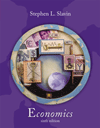|
 |  Economics, 6/e Stephen L. Slavin
Detailed ChangesChanges in the Sixth Edition of Slavin's Economics General Changes: Two general changes have been made in the Sixth Edition: (1) The number of "Questions for Further Thought and Discussion" at the end of each chapter has been almost doubled; (2) captions have been added to more than two thirds of the graphs in the text.Organizational Changes: We've made several major organizational changes, while cutting the number of chapters from 35 to 33. There's a much stronger emphasis on supply and demand toward the beginning of the text, and we've added a new chapter on the export-import sector of GDP. In addition, the chapter on economic growth was largely rewritten, and the early micro chapters were completely reorganized. Chapter 3. Supply and Demand: We've thoroughly beefed up a bare bones chapter to include a great deal of new material on shifts in demand and supply, price ceilings, price floors, shortages, and surpluses. Students need to develop these skills at the beginning of the course, since they will encounter supply and demand problems throughout the text. Chapter 8. The Export-Import Sector: This new chapter is part of the C + I + G + Xn sequence leading up to the GDP chapter. It provides an understanding of the basis for international trade, a topic that traditionally is not covered until the end of a principles text. The United States is not only the world's largest importer and exporter, but it runs, by far, the world's largest trade deficit. Also included are brief discussions of leading U.S. imports and exports, the world's leading trading nations, world trade agreements, the introduction of the euro, free trade zones, and recent protests against world trade organizations. The main purpose of this chapter is to introduce important issues of foreign trade, while leaving a more detailed and technical discussion to the chapter on international trade, near the end of the book. Chapter 16. Economic Growth and Productivity: For most of the 20 years preceding the mid-1990s, the American economy, while not exactly a basket case, was almost stagnant. Our rates of economic growth, productivity growth, and capital formation were lagging, while our federal budget deficit was roaring out of control. Our mayors and governors would lead trade missions to Japan and Europe, seeking companies willing to set up factories in their localities. Japanese business practices were all the rage, and America was the sick man of the world economy.
But by the mid-1990s, the American economy was roaring back, our economic growth, productivity growth, and capital formation were back on the fast track, while the federal budget deficit was being transformed into a large and growing surplus. The "new economy" had arrived, and the American economic model was emulated all over the world. And so, the million dollar question is: What accounted for this reversal of fortune? We've done our best to answer this question in this chapter, but if Regis Philbin were to ask, "Is that your final answer?" we would be forced to admit that it is not. It's way too soon to tell if the new economy is heralding a new economic state of grace, or merely a pleasant interlude. Chapter 17. Demand, Supply, and Equilibrium: Most of what had been in Chapter 17 was shifted to the current Chapter 3. The current Chapter 17 is a composite of what is left of Chapter 17, as well as parts of what had been Chapters 18 and 20. The dual emphasis of the chapter is now equilibrium analysis and the graphing of demand and supply curves. Students are shown how to lay out their graphs, draw the curves, and then find equilibrium price and quantity. These graphing skills are put to use in nearly all of the micro chapters that follow.Chapter 18. The Elasticities of Demand and Supply: The first half of the chapter (the elasticity of demand and elasticity and total revenue) was taken from what had been Chapter 18; the second half (the elasticity of supply and tax incidence) comes from the old Chapter 20. A new section, "Elasticity over Time" has been added, showing how supply grows increasingly elastic as we move from the market period through the short run to the long run.Chapter 20. Cost: In addition to cost analysis, which was retained from the old chapter 20, we have added the concepts of diminishing returns, economics of scale, diseconomies of scale, and the long-run planning envelope curve. There is a strong emphasis on drawing MC, AVC, and ATC curves.Chapter 21. Profit Maximization: This new chapter was put together from parts of three other chapters. Having been introduced to graphing, microanalysis, and numerous cost concepts in the preceding chapters, the student now gets to use marginal analysis extensively to find the firm's most profitable output and to calculate total profit. Although this requires fairly sophisticated micro analysis, we have led up to it step-by-step in the preceding chapters. By the end of this chapter, students are filling in cost tables, drawing graphs which include the MC, AVC, ATC, demand and MR curves, calculating total profit, and determining the lowest price the firm would accept in the short run and the long run. Most importantly, they are able to do this analysis using the graphs they have drawn. |
|
|



 2002 McGraw-Hill Higher Education
2002 McGraw-Hill Higher Education

 2002 McGraw-Hill Higher Education
2002 McGraw-Hill Higher Education